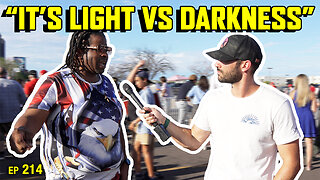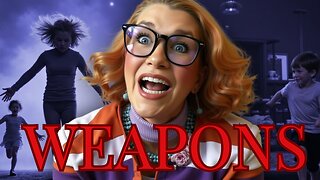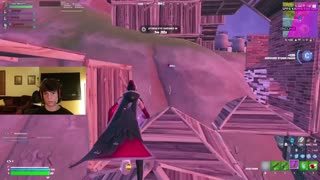Premium Only Content

Dark Fantasy: Dead Hands Reaching (May 22, 1942)
Setting: A contemporary (1942) American setting, likely a small town, isolated mansion, or urban tenement, with scenes possibly shifting to a graveyard, a ghostly realm, or a cursed space. The episode employs sound effects such as creaking doors, ghostly moans, clawing sounds, and howling winds to create a terrifying, otherworldly atmosphere, typical of Dark Fantasy’s vivid horror.
Plot:
Introduction: The episode opens with the show’s ominous theme music and announcer Tom Paxton (or possibly Keith Payton, as sources vary) introducing Dark Fantasy as a series of “tales of the weird and supernatural.” The narrator sets a grim tone, hinting at a story about spectral hands reaching from beyond the grave, evoking dread and the inescapable grip of death.
The Premise: The story likely centers on a protagonist—perhaps an ordinary citizen, grieving relative, or curious investigator—who encounters a supernatural phenomenon involving “dead hands” that reach out to claim the living. These hands could belong to vengeful ghosts, a cursed corpse, or a demonic entity tied to a specific location, object, or past sin. Bishop’s scripts often draw on Gothic and Lovecraftian influences, so the narrative might involve a haunted artifact (e.g., a ring or relic), a desecrated grave, or a family curse that unleashes the spectral hands, seeking retribution or a new victim.
Escalating Horror: As the protagonist investigates, the supernatural presence intensifies. They might feel cold, grasping hands in the dark, see ghostly appendages emerging from walls or graves, or hear chilling moans and clawing sounds, with effects like scraping nails or a heartbeat amplifying the terror. The hands could target the protagonist due to a connection to their past—a wrong they committed, a family secret, or an unwitting disturbance of a grave. The narrative might shift to a nightmarish realm where the hands pursue relentlessly, trapping the protagonist in a claustrophobic, ghostly encounter.
Climax and Resolution: The climax likely involves a desperate struggle to escape or appease the dead hands, requiring the protagonist to uncover the source of the curse—perhaps a hidden truth, a ritual, or a sacrifice. Bishop’s stories often feature a twist or ambiguous ending, so the protagonist might break the curse at great personal cost, temporarily repel the hands only to sense their lingering presence, or be claimed by the spectral force, leaving their fate uncertain. The episode concludes with the narrator reflecting on the inescapable reach of death, leaving listeners with “goose pimples” as Bishop intended.
Themes: The terror of vengeful death, the consequences of disturbing the dead, and the human struggle against supernatural retribution. The episode reflects Dark Fantasy’s blend of horror, psychological tension, and Gothic atmosphere, designed to unsettle listeners’ imaginations.
Cast and Roles:
Protagonist: Played by an unnamed actor, likely Ben Morris or Fred Wayne, portraying a relatable character facing the horror of the spectral hands. The performance would convey fear, desperation, and resolve, with vocal shifts to reflect supernatural terror, typical of Dark Fantasy’s intense acting style.
Supporting Characters: An ensemble of unnamed actors, possibly including Eleanor Naylor Caughron, Garland Moss, or Murillo Scofield, playing roles such as:
Antagonist/Ghostly Entity: A vengeful spirit or demonic force behind the hands, voiced with an eerie, menacing tone.
Family/Friends: Characters connected to the protagonist, offering warnings or falling victim to the hands, adding emotional stakes.
Minor Roles: A gravedigger, a town elder, or a mystic providing cryptic clues, voiced by the ensemble to enhance the eerie setting.
Narrator/Announcer: Likely Tom Paxton (or Keith Payton), delivering the opening and closing remarks with a somber, suspenseful tone, framing the story’s chilling mood.
Note on Cast: Dark Fantasy relied on WKY’s versatile in-house cast, with actors like Ben Morris and Eleanor Naylor Caughron known for their skill across radio dramas. Specific roles for “Dead Hands Reaching” are unlisted, as the series rarely credited individual performances, but the ensemble’s talent ensured a gripping delivery.
Production Details:
Music: Ominous orchestral or organ music, likely composed by WKY’s in-house musicians, opens and closes the episode, with eerie stings accentuating suspenseful moments. The score enhances the ghostly, supernatural mood, akin to Lights Out!’s atmospheric style.
Writer: Scott Bishop (George M. Hamaker), known for crafting tales that merge supernatural horror with Gothic and Lovecraftian elements, likely drawing inspiration from Edgar Allan Poe’s macabre tales or H.P. Lovecraft’s cosmic dread.
Director: Not explicitly credited, but likely overseen by WKY’s production team, ensuring the episode’s tight 30-minute pacing and immersive sound design.
Sound Effects: Crucial to the episode, including creaking doors, ghostly moans, clawing sounds, scraping nails, howling winds, heartbeats, or graveyard ambiance, creating a vivid, terrifying atmosphere. The “dead hands” might be represented by rustling or grasping sounds, amplifying their menace.
Sponsor: None, as Dark Fantasy was typically unsponsored, airing late Friday nights (often 11:30 PM) on NBC stations, supported by the network and WKY’s commitment to innovative programming.
World and National Events Around May 22, 1942:
To provide context for the broadcast, here are key world and national events occurring in mid-to-late May 1942, reflecting the wartime climate that shaped listeners’ perspectives:
World Events:
World War II – Pacific Theater: The Battle of the Coral Sea (May 4–8, 1942) concluded, with U.S. and Australian forces halting Japan’s advance toward Port Moresby, a strategic victory widely reported by mid-May, lifting spirits after the Bataan Death March (April 9–17), where thousands of U.S. and Filipino prisoners died under Japanese captivity. Preparations for the Battle of Midway (June 4–7) were underway, though not yet public, signaling a critical turning point.
Doolittle Raid Aftermath: The Doolittle Raid on Tokyo (April 18) continued to boost U.S. morale, with radio broadcasts in May praising its psychological impact on Japan and its galvanizing effect on Americans post-Pearl Harbor.
European Theater: Nazi Germany’s occupation intensified, with the Holocaust escalating. Deportations to death camps like Auschwitz and Sobibor increased, though U.S. awareness remained limited. Allied bombing raids, such as the May 17 raid on Cologne and the May 30–31 “Thousand Bomber” raid on Cologne, marked a growing offensive, covered on NBC and Mutual broadcasts.
Japanese Advances: Japan’s Pacific conquests, including Burma and the Philippines, threatened Allied supply lines. By late May, Japan was finalizing plans for the Midway invasion, heightening U.S. concerns about Pacific stability, a frequent topic on radio news.
National Events:
War Mobilization: The U.S. was fully engaged in World War II, with rationing of gas, sugar, rubber, and coffee in effect. The War Production Board prioritized military production, converting factories for tanks, planes, and ships, a shift emphasized in radio campaigns urging civilian sacrifice and war bond purchases.
Japanese American Incarceration: Executive Order 9066 (February 1942) continued to drive the relocation of Japanese Americans to internment camps like Manzanar, Tule Lake, and Minidoka. By May, tens of thousands were interned, a controversial policy debated in newspapers and on radio, reflecting wartime fears and prejudice.
Entertainment and Morale: Hollywood and radio played key roles in boosting morale. Films like Saboteur (released April 24), directed by Alfred Hitchcock, and Yankee Doodle Dandy (premiered May 29) were popular, while radio shows like The Bob Hope Show and Fibber McGee and Molly mixed humor with war bond appeals. Dark Fantasy’s horror provided escapism from war’s grim realities.
Sports and Culture: The 1942 baseball season was underway, with teams like the New York Yankees and St. Louis Cardinals drawing fans despite wartime restrictions. Bing Crosby’s “White Christmas,” recorded May 29, began its rise as a wartime anthem, while Ella Fitzgerald’s “A-Tisket, A-Tasket” remained a jazz hit, reflecting the era’s vibrant music scene.
-
 29:27
29:27
James Klüg
1 day agoAmericans Remembering Charlie Kirk
13.9K3 -
 9:36:11
9:36:11
GoA_Malgus
9 hours ago $0.13 earnedGoA Malgus - The Legend Has Returned!!! - Live domination on Black Ops 6
6.67K -
 48:15
48:15
SouthernbelleReacts
1 day ago $8.60 earnedWeapons (2025) REACTION | Josh Brolin, Julia Garner, Alden Ehrenreich | Horror-Mystery Thriller
36K21 -
 39:36
39:36
mizery
4 days ago $0.79 earnedI Mastered Fortnite in 30 Days
17.5K6 -
 25:50
25:50
ChopstickTravel
18 days ago $3.69 earned24 Hours With Sri Lanka’s Vedda People!! (Barehand Honey Harvest)
32.1K7 -
 8:13
8:13
Danny Rayes
1 day ago $2.61 earnedMost Hated Teacher on Tiktok
20K21 -
 15:31
15:31
Chris Harden
9 days ago $4.00 earnedWhat Happened to Kewanee, Illinois?
21.1K11 -
 10:13
10:13
JohnXSantos
1 day ago $0.72 earnedThis AI Tool Makes Product Manufacturing 10X Smarter (FOR FREE)
14.3K3 -
 16:28
16:28
Artur Stone Garage
12 days ago $1.81 earned$1000 AUDI A4 — WILL IT START After 10 Years?
17.9K1 -
 26:57
26:57
Advanced Level Diagnostics
18 days ago $0.84 earned2021 Ram Promaster - No Crank! Key Stuck In Ignition! Diag & Fix!
13K1